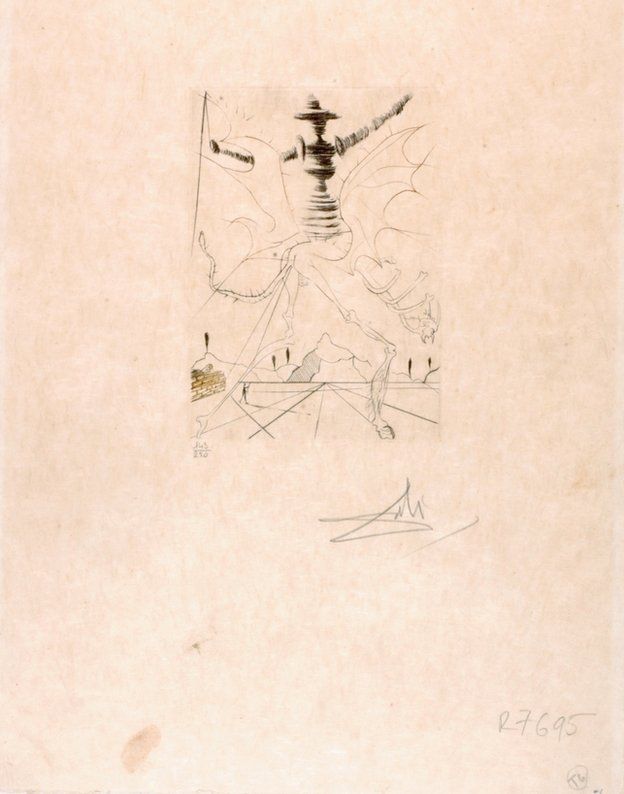The Indian museum 'ignoring' its Salvador Dali etchings
- Published

Should a leading Indian museum be doing more to tell the world about rare works it holds by the master of surrealism Salvador Dali?
Calcutta's Victoria Memorial Hall (VMH) holds two Dali colour etchings, thought to be the only originals any museum or gallery in India possesses by the Spanish master.
But they have been shown to the public only twice in the 24 years since the US-based, Calcutta-born artist Bimal Banerjee donated the works along with 81 other pieces of art to the museum.
The two untitled but signed etchings purportedly date back to 1946 when Dali released an illustrated edition of William Shakespeare's Macbeth.
This was in line with his literary illustrations for Dante's Divine Comedy, Lewis Carroll's Alice in Wonderland and Miguel de Cervantes' Don Quixote as well his interest in Shakespeare seen through original engravings entitled Much Ado about Shakespeare and Shakespeare II.
'Breached contract'
Printed on Japanese rice paper with cotton threads, the etchings are small but maintain the surrealist streak characteristic of Dali.
The two etchings are currently being exhibited for the first time since 1993.
However, there appears to be little attempt to showcase the prized exhibits. Visitors walk past the small glass enclosure where the untitled etchings are kept, and security personnel and officials fumble at the mention of Dali. The paper signage placed near the artworks bearing details like the artist's name and dimensions of the works is too small to grab people's attention.
Donor Bimal Banerjee is annoyed at the way the artworks have been displayed.
"Having gifted the 83 artworks, I drew up a contract with the Victoria Memorial which mentioned that all of the donations will have to be exhibited together in one hall or adjacent halls. It wasn't about Dali only. They have breached the contract and I feel that I've wasted $4m worth of gifts on ignorant people," he said in a telephone call from New York.
VMH curator Jayanta Sengupta says the museum doesn't have enough space for permanent display and its huge collection necessitates display by rotation.
"The bulk of our stock remains in storage. Cluttering the gallery is a concern we have," he adds.
The VMH, he says, is planning an exhibition of European and Western art in the near future and many of the 83 pieces of art donated by Mr Banerjee - works by Paul Klee, Jean Arp, Joseph Beuys, Robert and Sonia Delaunay and Robert Motherwell, as well as the Dalis - will be part of the show.
The VMH is known for its impressive collection of a genre of painting involving picturesque Indian landscapes and people. It also has many Mughal miniatures, lithographs and aquatints, arms and armoury, rare books, sculptures and paintings, including a notable selection of works by legendary Indian artists Jamini Roy and Abanindranath Tagore.
"Victoria Memorial's indifference towards my contribution only indicates how Indians don't care about contemporary art," says Mr Banerjee.
Mr Banerjee's website mentions his meeting with European and North American artists like Georgio de Chirico, Sonia Delaunay, Arman, and Beuys besides Dali, who gave him the two etchings in exchange for some of Mr Banerjee's own work after their 1972 meeting in Paris.
Earlier this year, the Vadehra Art Gallery in Delhi held an exhibition of prints by Dali and his fellow Spaniard Pablo Picasso.
The gallery's owner, Arun Vadehra, says all the Dali prints were immediately sold at $100 apiece - an indication, he says, of the stature and worth of an internationally-reputed artist like Dali in urban India.
"The possession of two Dali originals significantly increases the importance of Victoria Memorial as a museum and gallery. More people should know about it," Mr Vadehra said.
Back at the Victoria Memorial, Guillermo Gallego Nistal, a 27-year-old airline employee from Spain and a Dali fan, has spotted the prized etchings.
Last year, he visited the Catalonian town of Figueres in Spain where Dali was born and found inspiration from his paintings.
Jostled by other visitors and whistling security men, he peers intently into the glass-topped case housing the two Dali etchings.
The effect is "pretty surreal", he says.
"I wasn't really expecting to find a Dali here. It made me nostalgic seeing them."
Shamik Bag is a Calcutta-based independent journalist
- Published18 June 2013
- Published20 February 2013
- Published30 June 2012